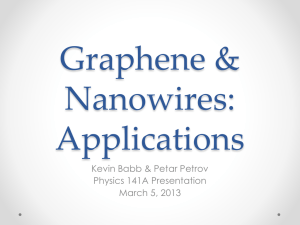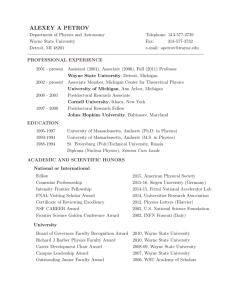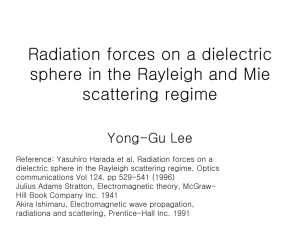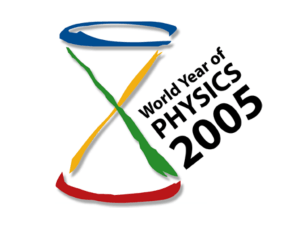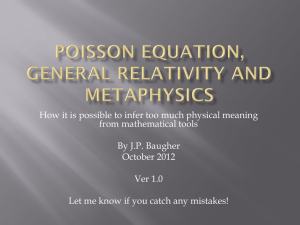The Petrov Classification of Gravitational Fields
advertisement
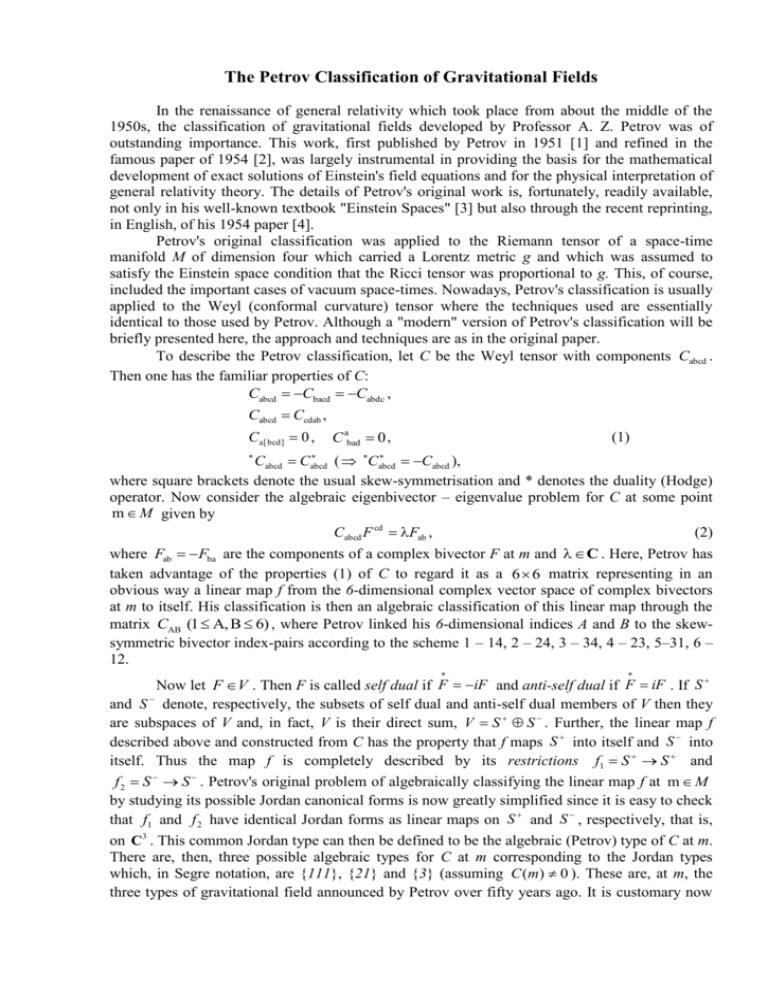
The Petrov Classification of Gravitational Fields
In the renaissance of general relativity which took place from about the middle of the
1950s, the classification of gravitational fields developed by Professor A. Z. Petrov was of
outstanding importance. This work, first published by Petrov in 1951 [1] and refined in the
famous paper of 1954 [2], was largely instrumental in providing the basis for the mathematical
development of exact solutions of Einstein's field equations and for the physical interpretation of
general relativity theory. The details of Petrov's original work is, fortunately, readily available,
not only in his well-known textbook "Einstein Spaces" [3] but also through the recent reprinting,
in English, of his 1954 paper [4].
Petrov's original classification was applied to the Riemann tensor of a space-time
manifold M of dimension four which carried a Lorentz metric g and which was assumed to
satisfy the Einstein space condition that the Ricci tensor was proportional to g. This, of course,
included the important cases of vacuum space-times. Nowadays, Petrov's classification is usually
applied to the Weyl (conformal curvature) tensor where the techniques used are essentially
identical to those used by Petrov. Although a "modern" version of Petrov's classification will be
briefly presented here, the approach and techniques are as in the original paper.
To describe the Petrov classification, let C be the Weyl tensor with components Cabcd .
Then one has the familiar properties of C:
Cabcd Cbacd Cabdc ,
Cabcd Ccdab ,
Ca [ bcd ] 0 ,
C abad 0 ,
(1)
Cabcd Cabcd
Cabcd ),
( Cabcd
where square brackets denote the usual skew-symmetrisation and * denotes the duality (Hodge)
operator. Now consider the algebraic eigenbivector – eigenvalue problem for C at some point
m M given by
Cabcd F cd Fab ,
(2)
where Fab Fba are the components of a complex bivector F at m and C . Here, Petrov has
taken advantage of the properties (1) of C to regard it as a 6 6 matrix representing in an
obvious way a linear map f from the 6-dimensional complex vector space of complex bivectors
at m to itself. His classification is then an algebraic classification of this linear map through the
matrix CAB (1 A, B 6) , where Petrov linked his 6-dimensional indices A and B to the skewsymmetric bivector index-pairs according to the scheme 1 – 14, 2 – 24, 3 – 34, 4 – 23, 5–31, 6 –
12.
Now let F V . Then F is called self dual if F iF and anti-self dual if F iF . If S
and S denote, respectively, the subsets of self dual and anti-self dual members of V then they
are subspaces of V and, in fact, V is their direct sum, V S S . Further, the linear map f
described above and constructed from C has the property that f maps S into itself and S into
itself. Thus the map f is completely described by its restrictions f1 S S and
f 2 S S . Petrov's original problem of algebraically classifying the linear map f at m M
by studying its possible Jordan canonical forms is now greatly simplified since it is easy to check
that f1 and f 2 have identical Jordan forms as linear maps on S and S , respectively, that is,
on C3 . This common Jordan type can then be defined to be the algebraic (Petrov) type of C at m.
There are, then, three possible algebraic types for C at m corresponding to the Jordan types
which, in Segre notation, are {111}, {21} and {3} (assuming C (m) 0 ). These are, at m, the
three types of gravitational field announced by Petrov over fifty years ago. It is customary now
to label these types so as to include the two possible algebraic degeneracies in each of the first
two types. Thus the modern version of this classification is
Petrov type I
({111} – no degeneracies)
Petrov type D
({(11)1})
Petrov type II
({21} – no degeneracies)
Petrov type N
Petrov type III
({(21)})
({3}).
(3)
In the types N and III the tracefree property in (1) shows that all eigenvalues of f (or f1
and f 2 ) are zero. One normally adds a Petrov type O to cover the possibility of C (m) 0 .
However, it must be remembered that Petrov's classification is pointwise and the Petrov type can
be expected to vary from point to point on M (subject, of course, to continuity restrictions).
Since Petrov's original papers appeared, several other approaches to his classification
have been proposed. Perhaps the best known of these are the spinor classification of Penrose [5]
and the approach centred on "principal null directions" due mainly to Bel [6] (but augmented by
Debever [7] and by Sachs, Ehlers and Kundt [8], [9]). In these approaches one looks for
solutions for a null vector k at m such that
(4)
k[eCa ]bc [d kf] k b k c 0 .
Such a solution k is said to span a principal null direction of C. It turns out that there is at least
one and at most four independent such solutions and, in fact, four in the type I case, three for
type II, two for each of the types D and III (and which be distinguished by a more detailed
examination of (4)) and one for type N. These approaches greatly facilitated the process of
calculation using Petrov's classification.
As well as being a beautiful piece of mathematics, Petrov's classification led to much
progress in the physics of general relativity. In particular, by being able to study Einstein's field
equations for a particular Petrov type, many more exact solutions of Einstein's equations were
found. Also, by use of the elegant geometrical concepts involved (and analogies with Maxwell's
electromagnetic theory) the physical interpretation of general relativity was greatly clarified.
Petrov's classification scheme is, indeed, one of the major developments in Einstein's general
relativity theory.
Professor Graham Hall
Department of Mathematical Sciences
University of Aberdeen,
King's College,
Aberdeen AB243DG,
Scotland, UK
References
1. A. Z. Petrov. Dokl. Akad. Nauk SSSR. XXXI, 149-152 (1951).
2. A. Z. Petrov. Scientific Proceedings of Kazan State University, 114, 55-69 (1954).
3. A. Z. Petrov. "Einstein Spaces", Pergamon Press (1969).
4. A. Z. Petrov. Gen. Relat. Gravit. 32 (2000), 1665-1685.
5. R. Penrose. Anns. Phys. 10 (1960), 171.
6. L. Bel. Cah. de. Phys. 16 (1962), 59 (reprinted in Gen. Relat. Gravit. 32 (2000),
2047).
7. R. Debever. C. R. Acad. Sci. (Paris), 249 (1959), 1744.
8. R. K. Sachs. Proc. Roy. Soc. A264 (1961), 309.
9. J. Ehlers and W. Kundt. In "Gravitation: An introduction to Current Research", ed. L.
Witten. Wiley, New York (1962), 49.

